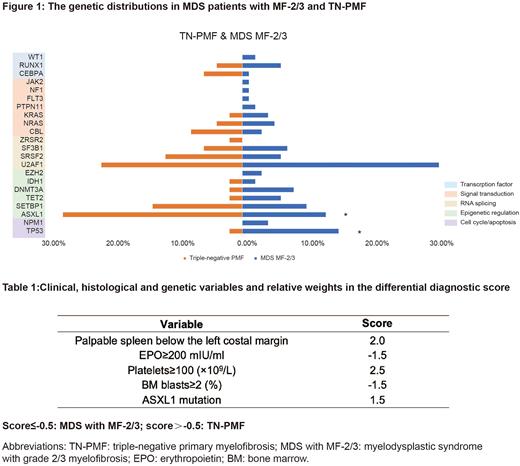Abstract
Introduction: Approximately half of patients with myelodysplastic syndromes (MDS) have mild bone marrow fibrosis (MF-1), clinical features, mutation profile and prognostic significance, which are incompletely studied. Additionally, MDS with moderate-to-severe bone marrow fibrosis (MF-2/3) shares features with primary myelofibrosis (PMF). However, there is no detectable driver mutation in approximately 10% of subjects with PMF, which is termed triple-negative PMF (TN-PMF). Distinguishing MDS with MF-2/3 from TN-PMF is often elusive when there is substantial bone marrow fibrosis and no typical PMF driver mutation.
Methods: We retrospectively evaluated data from 1,263 consecutive subjects with de novo MDS (N = 1,020) or overt PMF (N = 243) at our center from 1/12/2011-31/12/2020. Targeted gene sequencing was performed for 112 myeloid-related genes in all subjects at diagnosis. The grade of bone marrow fibrosis was independently evaluated by two pathologists according to the European consensus guidelines. A stepwise logistic model was conducted to evaluate the discrimination power of each covariate to develop a differential diagnostic model. Receiver-operator characteristic curves (ROCs) were used to define optimal cut-off values, and the area under the ROC curve (AUROC) was used to define prediction accuracy between the model and the histological diagnosis.
Results: 648 (64%) men and 372 (36%) women with de novo MDS had a median age 55 years (range, 14-83 years) and a median follow-up 37 months (range, 2-140 months). A total of 494 (48%) of the MDS subjects had MF-0, 391 (38%), MF-1, 102 (10%), MF-2 and 7 (1%), MF-3.
Compared with the subjects with MF-0, those with MF-1 were older (P = 0.006), had a lower hemoglobin level (P = 0.006), a lower mean corpuscular volume (MCV; P = 0.006), a higher percentage of bone marrow (BM) blasts (P = 0.02), higher Revised International Prognostic Scoring System (IPSS-R) scores (P = 0.01) and worse IPSS-R-defined cytogenetics (P = 0.02).
The mean mutation frequency was higher in the subjects with MF-1 than in those with MF-0 (1.55 versus 1.13; P < 0.0001). The subjects with MF-1 had a higher frequency of ASXL1 and U2AF1 mutations than the subjects with MF-0 (ASXL1: 17% versus 11% [P =0.006]; U2AF1: 23% versus 16% [P = 0.01). Conversely, there was a higher frequency of CEBPA mutations in the subjects with MF-0 than in those with MF-1 (4% versus 1% [P = 0.009). The subjects with MF-1 also had poorer survival than MF-0 (hazard ratio [HR] = 1.26; 95% confidence interval [CI], 1.003, 1.590; P = 0.046).
Forty-eight of 243 subjects with PMF (19.8%) had TN-PMF. We compared the clinical and genetic features of these subjects with those of subjects with MDS MF-2/3. The WBC, neutrophil, lymphocyte, eosinophil, basophil, platelet and reticulocyte concentrations (P values from < 0.0001 to 0.015) were higher in the TN-PMF cohort. Increased LDH (P = 0.015) and splenomegaly (P < 0.0001) were more frequent in the TN-PMF cohort. But the percentage of BM blasts (P < 0.0001), EPO concentrations (P = 0.002) and MCV (P = 0.012) were significantly higher in the MDS with MF-2/3 group. The subjects with MDS with MF-2/3 were more likely to have a TP53 mutation (2% versus 17%; P = 0.01), whereas ASXL1 mutations were enriched in those with TN-PMF (29% versus 11%; P = 0.005,Figure 1).
Next, we developed a differential diagnostic model to distinguish MDS with MF-2/3 from TN-PMF based on clinical and genetic covariates, including palpable spleen, EPO levels, platelet counts, BM blasts and ASXL1 mutations (Table 1). According to the ROC analysis, a cut-off value of -0.5 was associated with an optimal sensitivity of 89.5% and specificity of 71.2% for diagnosing MDS with MF-2/3 from TN-PMF (AUC 0.874; 95% CI, 0.805-0.943).
Conclusion: Mild fibrosis in MDS presented adverse clinical features, more putative somatic mutations, distinctive genomic profile and worse prognostic prediction compared with MDS subjects with no fibrosis. These findings suggest more attention in therapeutic decision-making and personalized prognostic prediction for MDS patients with mild fibrosis. More importantly, we developed an unprecedented differential diagnostic scoring model containing common clinical, laboratory and molecular variables to efficiently differentiate TN-PMF and MDS with MF-2/3 in routine clinical work.
Disclosures
No relevant conflicts of interest to declare.
Author notes
Asterisk with author names denotes non-ASH members.


This feature is available to Subscribers Only
Sign In or Create an Account Close Modal